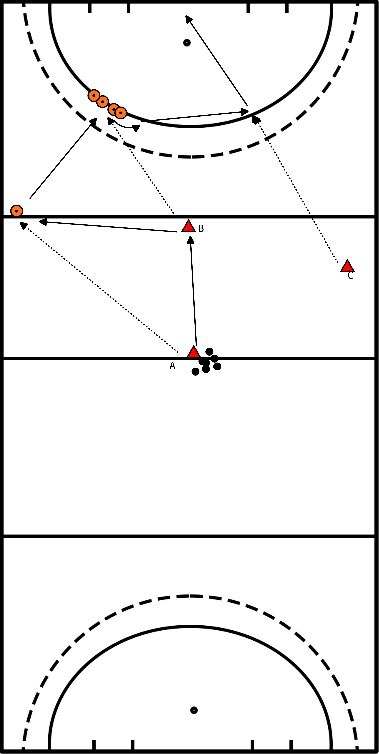Hockey drills
- Use pilons to set up two squares
- Around the dotted head circle (left and right next to/opposite the goal)
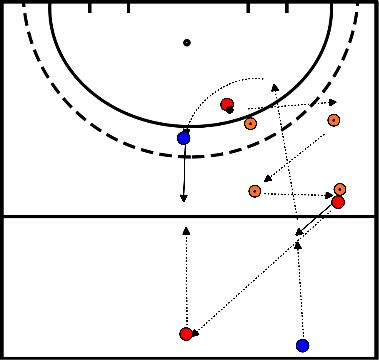
- Put out the pilons as shown in figure three, distribute the balls over pilons C and D.
- In this exercise you place one player each at pilons C and D, the rest of the team will line up at pilon A.
- From A the player runs around the pilon, from the pilon the player makes a sideways movement facing the ball (facing C).
- Player C plays the ball in the forehand of A, A takes the ball and opens to the right, runs towards the circle and finishes at goal.
- From here, he runs towards D and receives another ball.
- The player spins open to the left and finishes on goal again.
- Put out six pilons in a row with +/- five meters between each pilon.
- This is best done on the 23 meter line as shown in figure 1.
- Again make two rows and let the team sprint from the sideline to the first pylon and back, then from the sideline to the second pylon and back.
- Repeat this until the sixth pylon.
- After these sprint exercises let the team run half a lap.
Aim:
- To become physically as well as technically warm as preparation for the training.
Design:
- The exercise will be done with a maximum of 4 people.
- Of course you can put a multiple of these so that the exercise still works.
- The players 1 start with the ball and play it to their players 2. Then they change positions.
- Players 2 play the ball back to players 1 and also change positions.
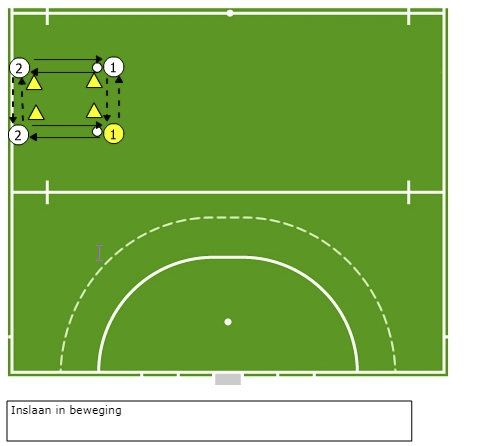
Variations:
- You can vary the way of passing (hitting, push, flats)
- Increase the distance between the pilons so that one only has to walk further.
- Increase the distance between the pilons so that one only has to move on.
- Increase both distances.
- Increase speed
- Make as many successful passes as possible in time.
Points of attention:
- Sit low for good control.
- Stick to the ground at ball control.
- Play ball on the forehand side.
- Stand still at ball acceptance.
Passing and scoring
- Each pilon has a player on it.
- Player A plays wide to the left to player B and chases the ball.
- Player B plays the ball diagonally to the right to player C and chases the ball
- Player C plays wide to the left to player D and chases the ball
- Player D plays diagonally to the right the ball to player E and chases after the ball
- Player E takes on and scores with flat / stroke
- Player E continues to the left around the extra pilons (out of practice) back to position A
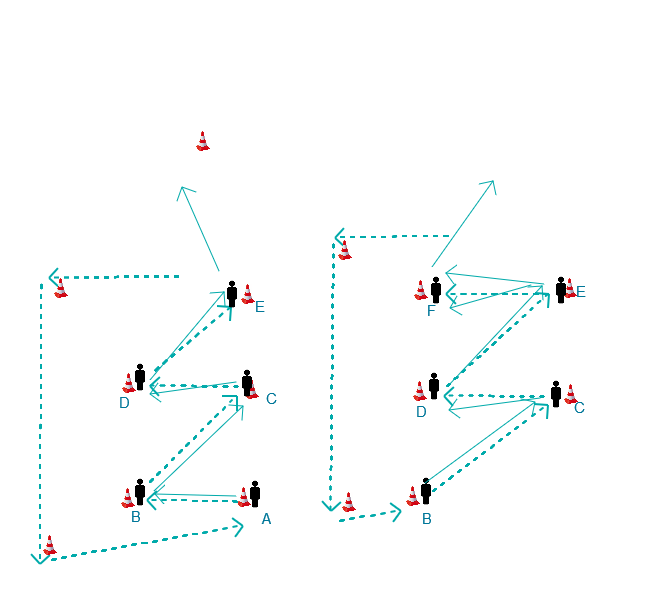
Variation:
- Balls start on the left from position B (pilon/position A is omitted), before that a pilon is added to the edge circle (position F).
- player 1 plays the ball from position B diagonally to the right to player 2 at position C and chases the ball
- Player on C plays wide to left to player in position D and chases after the ball
- Player in position D plays the ball diagonally to the right to player E and chases after the ball
- Player in position E plays wide to the left to player in position F and chases the ball
- Player in position F takes on the fh or high bh and scores with a (backhand) stroke and
- Runs outside the exercise to start position (B)
Variation 2:
- 2 rows of players behind pilons A and B
- Player 1 plays the ball wide to the left and runs straight to position C
- player 2 takes the ball and plays player 1 diagonally to the right in the fh while running (towards position C) and runs straight ahead towards position D.
- player 1 takes the ball in the fh around position C and plays the ball wide / backwards back to player 2 (towards position D) and runs to position E
- player 2 takes the ball (preferably with fh) and with foot position in direction E and plays the ball diagonally forward back to player 1 (direction E: rather just in the circle / edge circle than behind player 1)
- player 1 takes on and strikes / fats as fast as possible towards goal (do not bring the ball back) and runs outside exercise back to position B
Variation on 2:
- After that player 2 has delivered the ball to player 1 the 2nd time / last time, he / she becomes (passive) defender at the next set
- the defender is not allowed to go into the circle (or rather not even behind the line (position C/D) from where he/she started (position D)
- takes off the ball then floats over a line between position A and B.
- The 2 players that come up stay inside the box (width of pass lines) but are free in construction, they may also cross behind, cross over but no passes in the air (no lifts).
- the No. 1 scores and, just like the defender, runs outside back to another position. The No. 2 becomes defender
Accents:
- hands apart while controlling
- foot positioning open
- control it for a follow-up pass or even a quick bounce back
- Score after 2 contacts (control, max 1 other touch)
- see hands/feet position/distance from the ball at hitting and flats accents
- Taking the ball and passing it straight back
- Crossing diagonally with warm-up exercise
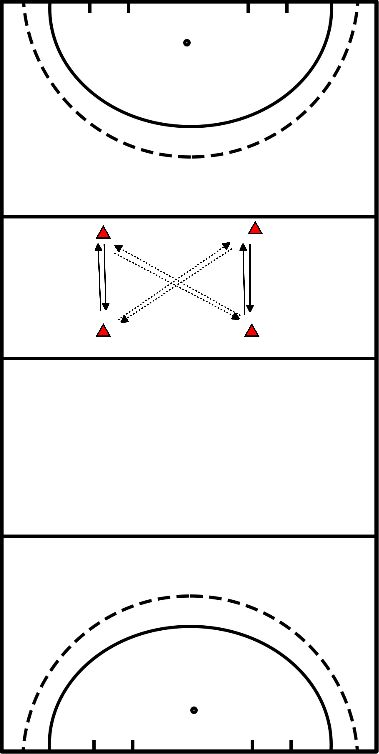
- Player A passes the pawns.
- Passes hard and cleanly to player B.
- A runs away from B.
- B passes to A and the latter takes to the run.
- Brings into the circle and rounds.
Points of attention:
- Fast, hard and clean passing.
- Takeover in the run.
- Keep speed.
Possibly extend with a defender in the circle.
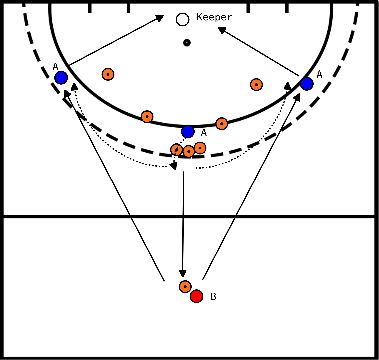
Put out as many times as there are players:
- Each player has their own pawn.
- They play 1-1 with the person opposite them.
- The ball is in the middle.
- At the whistle, they start trying to tap the other person's pawn.
- After a certain time, blow the whistle.
- Player who won moves one space to the right on the loser 1 to the left.
- In case of a tie; stone paper scissors.
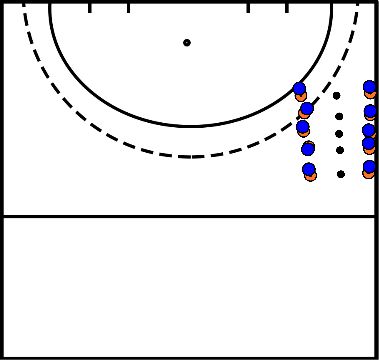
- Set up the square with pawns as in the drawing.
- 2 teams of 3 people are formed. One team gets balls and the other team gets vests.
- One team may start with 1 player leaving with 1 ball to the square.
- A player from the vests team may then leave.
- Players may either put down an item or move an item.
- The team with 3 in a row first has won.
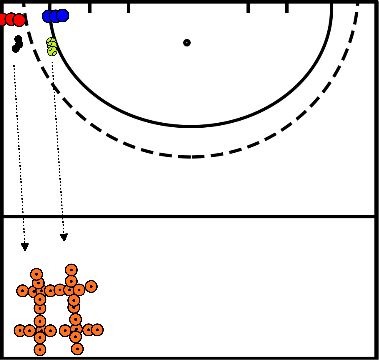
- Player A runs toward balls.
- Players B and C towards field of play.
- Player A takes the ball out -saves in.
- Players B and C offer themselves, being covered by the two defenders.
- Player A may make a selfpass.
- Attackers score in the big goal.
- Defenders if they get the ball, score in goal X.
Areas of focus are: quick take, offering, run and play lines, tackleback.
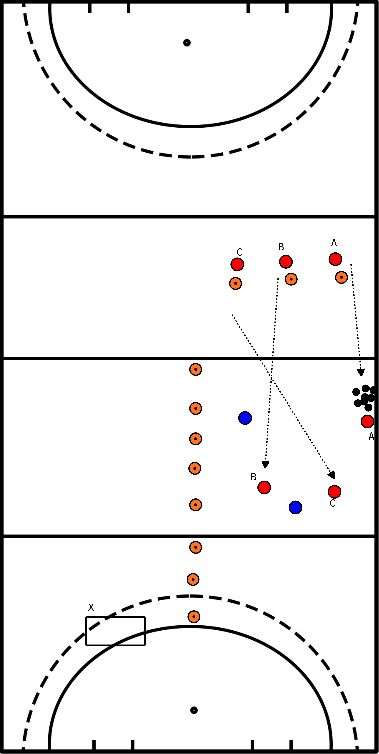
- Half Field.
- In the middle of the half field set out a square with pawns, players are not allowed to walk through it with the ball, but are allowed to walk through it without the ball.
Set a goal; for example:
- First play with your team 4x before you can score.
- Try with at least 3 or more players in the circle to outplay the goalkeeper during the attack. Do not aim for the ball to go straight to goal when you enter the circle but look for the right passing options.
- Try to build up the attack from the sides.
- Always try to have someone at the guard.
- Put a bowl down if the attack threatens to fail.
- You can also say; the ball must go around the back of the box per new attack if they are going to be huge on a bowl.
- -. Or if a goal attempt fails that then the ball must first be taken out of the circle before a new attempt may be made.
Additional difficulty: always enlarge the box if the attack goes well
Questions to the players:
- What is the best way to set up an attack?
- What is the best way to defend an attack?
- Which side do you want to guide the attacker to when you are defending?
- Which side do you want to attack from?
- First play with your team 4x before you can score.
- Try with at least 3 or more players in the circle to outplay the goalkeeper during the attack. Do not aim for the ball to go straight to goal when you enter the circle but look for the right passing options.
- Try to build up the attack from the sides.
- Always try to have someone at the guard.
- Put a bowl down if the attack threatens to fail.
- You can also say; the ball must go around the back of the box per new attack if they are going to be huge on a bowl.
- -. Or if a goal attempt fails that then the ball must first be taken out of the circle before a new attempt may be made.
Additional difficulty: always enlarge the box if the attack goes well
Questions to the players:
- What is the best way to set up an attack?
- What is the best way to defend an attack?
- Which side do you want to guide the attacker to when you are defending?
- Which side do you want to attack from?
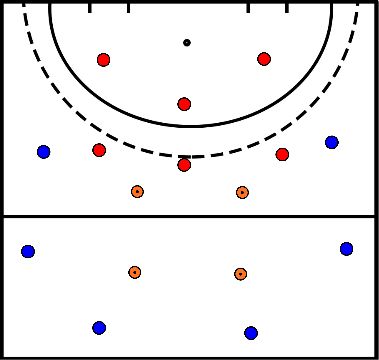
A one-two in depth with quick passes and finishing at high pace:
- Player A plays towards player B.
- A runs deep towards the first pawn -running line-.
- B passes back to A and runs deep towards the circle -short quick action-.
- A passes back to B.
- B takes on the forehand and spins away over the opponent's backhand -pawn-.
- C sprints in towards head of circle -timing-.
- B passes towards C possibly with the backhand sweep pass.
- C takes on, brings the ball into the circle and rounds. 2 actions, ball under control and round off.
